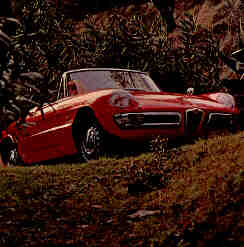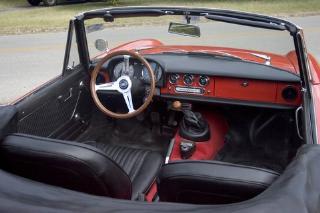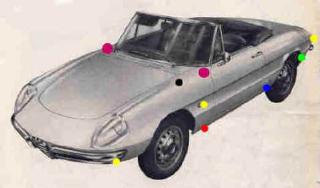Another good sign of how a car
has been cared for is its trim. Vinyl-trimmed interior
barely has space for four, even with the hood down. It
is a genuine Spider, a two-seater. Check the
upholstery: if it's bad, you may need to refurbish the
whole interior. The vinyl interior came in four
colors, black, purple, red and beige or tan. Check
that the little components are present, because some
are expensive to replace or even impossible. Well, not
quite, but they cost. In particular, check the
dashboard carefully if the car in question is a
right-hand drive, these dashboards are now
unavailable, as far as I know.

The chrome work on the older Alfas 1966 to say 1974 is
excellent. Bumpers are still in good condition even
after ten to twenty years or more. Some of the later
cars have dreadful chrome. The base metal is so poor
that pitting is inevitable. This is sometimes the case
with the chromed attaching points for the hardtop.
The front suspension, with an
unusual amount of expensive forging, must have been
designed for use on Italian back roads. It is very
solid and problems are rare. The same system was used
on the other 105-series cars by Alfa Romeo.
The steering is normally most
precise, but if there is some play, the tie-rod ends
need to be replaced. This is easy work for the DIY,
but remember to have someone else double-check the
steering after repair. Alfas came with worm and roller
or re-circulating ball.
Look at the hood, too. Very
well designed, it is quite tough; but if, through long
use, it needs replacement, expect to pay for a
re-manufactured item. The fitting might be tricky, but
several companies send the manual together with the
top to make things easier for the DIY

The Alfa Romeo
twin-cam light alloy engines are well known for their
sweet, punchy and responsive performance. Check the
engine type too. Durability is a well earned
reputation. When buying a Spider, always check the car
with a cold engine. Every bad sound will sound even
worse when the engine is cold. I.e. ticking valves,
worn bearings, the gearbox, in fact everything.
To check a
possible object under hard conditions, drive the car
when it's cold. See if the gears all shift nicely.
Listen and make sure it doesn't stumble or spit or
backfire. Blue smoke is common and will cost new
piston rings. All of these are bad and suggest it is in
need for repairs. Euro cars have carbs by Weber or
Dell'Orto, some even have Solex.
US had thanx to
emission regulations SPICA pumps. Tell the seller not
to start the car before you get there and when you get
there, open the hood, put your hand down and feel the
motor and the exhaust. If it's warm, leave the hood
open to cool it down a few hours.
Alfa
Romeo 1750 Spider Veloce
However, the
aluminum alloy blocks do need tender love and care.
Once the Spider is yours, warm up the engine before
driving under pressure or high revs. Let the engine
idle some minutes before take off. It will help you
keep the engine and the car in good shape for a long
period of time. Do not rev more than 2.500 rpm during
the first 5 kilometers or 3 miles.
The more care you
take during warming up the engine, the less problems
you will have. BTW, the engine sump will take 11.6
pints or 6,5 liters of quality oil, so it is very big!
The four-cylinder all-alloy engine features overhead
twin cams, wet liners, sodium-cooled exhaust valves of
large dimensions, large sump in alloy.
Alfa's
hemispherical combustion chambers offer centrally
located spark plugs and extremely short intake and
exhaust ports. Most of the water pump's output is
delivered through long slots in the exhaust port area.
The all aluminum
block weighs just 40 pounds or ten kilos, studs and
all. It accepts four cast iron cylinder barrels,
liners, with pop-up pistons and well designed rods.
The crank is fully counterweighted, reducing the loads
at the main bearing web. These tall main bearing caps
and long studs complete a sturdy, solid bottom end.
The oil-pump is a two gear affair, more rugged than
internal gear pumps. The sump has an elaborate series
of baffles to help retain the oil in the pick-up area
during hard cornering. The sump is extensively finned.
No problems there.
Do not forget the
tune up history. Was it maintained by a reputable Alfa
repair shop? Check with you AROC-friends. Did the
owner maintain it? If so, does he or she have records
indicating when things like when the oil was changed,
spark plugs and that sort of thing. Do not forget to
look for excessive amount of oil in and around the
engine compartment and on the hood, this will point to
an older motor that may be in need of repair. Do not
be afraid of a little oil build up, this is normal for
an all aluminum motor. Things need to be tightened a
little bit every month or so.
Check that the
block is not cracked or corroded. Head gaskets are
another common failure point, plus the "O"
rings under the camshaft bearings. Look for traces of
oil down the side of the block from the head. If so,
the head may be checked for flatness and the
"O" rings replaced together with the gasket.
Oil traces in the air cleaner indicate worn piston
rings, not a serious problem for the skilled Alfista.
Read how to replace them nice and easy with the engine
in the bay. The cooling system is quite large and very
solid. Some owners have modified and improved it. Read
more here.
In the
transmission department, there are few problems to
worry about. In case the synchros need some attention
or replacement, the gearbox might be removed from
underneath with the engine still in the bay. This
procedure is common for any garage where they replace
the clutch friction pads. Rugged gearbox offers evenly
balanced acceleration and cruising through a careful
choice of ratios.
Fifth gear, not
an overdrive, as standard, was something to shout
about in 1966 when most cars only had three or four
gears. All gears were syncro, but the second syncro
might be worn on high mileage cars. Check gears again
when the engine and gearbox are warm. The clutch by
Fichtel & Sachs is operated hydraulically and most
solid.
Prop shaft universal-joints, "doughnuts", can often
loosen, producing a knocking sound from under the
floor. This is annoying, but it isn't a serious
problem, easy and cheap to solve.
Suspension
systems are very strong, but check the rear end for
sagging. Look at the bump stops, if the rubber is worn
or even missing, the springs are probably worn. Any
tuning company offers shock absorbers. Yellow Konis
are popular among Alfisti. Cars with single circuit
brake system use floor pedals, that was between 1966
to 1969. Only a few Duetto have a brake servo.
The 1750 Spider
Veloce started with a single circuit, but came with a
twin booster very soon. Check for soft brake pedal
because, if there are leaks, rebuilding the braking
set-up can be long and arduous. Brake master cylinder
on floor pedal system are sometimes hard to find.
Check the brakes like this. The Spider came with
hanging pedals in 1969. Long-lasting exhaust systems
come in sections. If you spot a hole, replace the
section instead of the whole system. Stainless steel
system was not an Alfa fitment nut are common in
Europe.
Although the
Spider is not as fragile as some other Alfa Romeos
are, it does need looking after. Unfortunately, older
cars are likely to have had less-than-scrupulous
owners taking care of them. This makes a careful
check-over all the more important. Engage the service
of an inspection specialist if you are serious about a
Spider and you won't be disappointed. The prospect of
coping with a bad one, though, Spider is far more
daunting.
Because of the
high European prices and the sheer number of cars in
the US, importing a Spider from the States can be
economic. Their fuel-injected engines easily identify
American Spiders by SPICA, extra lightning and federal
bumpers. Converting a SPICA engine to Webers is
common, but if the fuel injection works OK, why
bother?
Summary, start by checking:

- •Rust at jacking points. Red dot. Feel the
edges of the sills all the way, even underneath.
If they feel pitchy, check even more.
- •Lift carpets to check floor for rust. Have a
glance behind and under the seats too. Lift the
rubber carpet behind the seats and hood.
- Check wheel arches for rust. Again, use your
fingertips. The edges should feel clean and smooth
without any pitches.
- Rear wings are notorious water-traps, check for
rust, even from underneath. Green dot.
- Boot floor, around tank and spare wells, another
rust spot. Lift the entire rubber math and look
under it.
- Front panels, upper part close to doors, also a
rust spot. Purple dots.
- Lower area between door and rear wheel, rust
spot close to the farina badge. Blue dot.
- Brake system and booster's).
- Missing or damaged headlamp cowls. Later US cars
did not have them.
- Missing or damaged lights and lenses. Especially
the tear-drop lens at the panel side, close to the
door, is hard to find. Later Spiders had a round
one instead. Yellow dots
- Rear bumper stops for sagging rear suspension.
Check both sides for the rubber dumber, fixed to
the body just above the ends of the live rear
axle.
- Dashboard for cracks. RHD dashboards are hard to
replace.
- Interior and instruments. Jaeger gauges are what
you should have in a Spider.
- Engine for cracks and leaks. Oil leaks between
head and block indicate you will need a new gasket
before long.
- As with any Alfa Romeo engine, blue smoke
when accelerating and stopping, tells you to check
the engine at your Alfa garage.
- Second gear syncro. Common on any Alfa.
- Hood, sturdy but might be costly to replace.
Came in black and tan and was easy to handle by
one person. The Spiders also had a hood-bag as an
option.
- Rearview mirror at front panel instead of door
tells you that it's an old Spider. Black dot.
- If it has, you are facing a Duetto or an early
1750 Veloce. . . lucky you!
If you find a Spider and you like it, buy it and
have fun and join your local AROC!